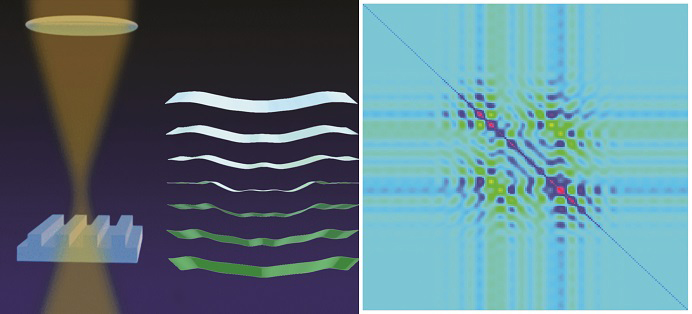December 2, 2015
National Institute of Standards and Technology (NIST) researchers are seeing the light, but in an altogether different way. And how they are doing it just might be the semiconductor industry's ticket for extending its use of optical microscopes to measure computer chip features that are approaching 10 nanometers, tiny fractions of the wavelength of light.
Using a novel microscope that combines standard through-the-lens viewing with a technique called scatterfield imaging, the NIST team accurately measured patterned features on a silicon wafer that were 30 times smaller than the wavelength of light (450 nanometers) used to examine them. They report* that measurements of the etched lines—as thin as 16 nanometers wide—on the SEMATECH-fabricated wafer were accurate to one nanometer. With the technique, they spotted variations in feature dimensions amounting to differences of a few atoms.
Measurements were confirmed by those made with an atomic force microscope, which achieves sub-nanometer resolution, but is considered too slow for online quality-control measurements.
Combined with earlier results, the NIST researchers write, the new proof-of-concept study* suggests that the innovative optical approach could be a "realistic solution to a very challenging problem" facing chip makers and others aiming to harness advances in nanotechnology. All need the means for "nondestructive measurement of nanometer-scale structures with sub-nanometer sensitivity while still having high throughput.
"Light-based, or optical, microscopes can't "see" features smaller than the wavelength of light, at least not in the crisp detail necessary for making accurate measurements. However, light does scatter when it strikes so-called subwavelength features and patterned arrangements of such features.
"Historically, we would ignore this scattered light because it did not yield sufficient resolution," explains Richard Silver, the physicist who initiated NIST's scatterfield imaging effort. "Now we know it contains helpful information that provides signatures telling us something about where the light came from."
With scatterfield imaging, Silver and colleagues methodically illuminate a sample with polarized light from different angles. From this collection of scattered light—nothing more than a sea of wiggly lines to the untrained eye—the NIST team can extract characteristics of the bounced lightwaves that, together, reveal the geometry of features on the specimen.
Light-scattering data are gathered in slices, which together image the volume of scattered light above and into the sample. These slices are analyzed and reconstructed to create a three-dimensional representation. The process is akin to a CT scan, except that the slices are collections of interfering waves, not cross-sectional pictures.
"It's the ensemble of data that tells us what we're after," says project leader Bryan Barnes." We may not be able see the lines on the wafer, but we can tell you what you need to know about them—their size, their shape, their spacing."
Scatterfield imaging has critical prerequisites that must be met before it can yield useful data for high-accuracy measurements of exceedingly small features. Key steps entail detailed evaluation of the path light takes as it beams through lenses, apertures and other system elements before reaching the sample. The path traversed by light scattering from the specimen undergoes the same level of scrutiny.
Fortunately, scatterfield imaging lends itself to thorough characterization of both sequences of optical devices, according to the researchers. These preliminary steps are akin to error mapping so that recognized sources of inaccuracy are factored out of the data.
The method also benefits from a little advance intelligence—the as-designed arrangement of circuit lines on a chip, down to the size of individual features. Knowing what is expected to be the result of the complex chip-making process sets up a classic matchup of theory vs. experiment.
The NIST researchers can use standard equations to simulate light scattering from an ideal, defect-free pattern and, in fact, any variation thereof. Using wave analysis software they developed, the team has assembled an indexed library of light-scattering reference models. So once a specimen is scanned, the team relies on computers to compare their real-world data to models and to find close matches. From there, succeeding rounds of analysis homes in on the remaining differences, reducing them until the only ones that remain are due to variations in geometry such as irregularities in the height, width, or shape of a line.
Measurement results achieved with the NIST approach might be said to cast light itself in an entirely new light. Their new study, the researchers say, shows that once disregarded scattered light "contains a wealth of accessible optical information."
Next steps include extending the technique to even shorter wavelengths of light, down to ultraviolet, or 193 nanometers. The aim is to accurately measure features as small as 5 nanometers.
This work is part of a larger NIST effort to supply measurement tools that enable the semiconductor industry to continue doubling the number of devices on a chip about every two years and to help other industries make products with nanoscale features. Recently, NIST and Intel researchers reported using an X-ray technique to accurately measure features on a silicon chip to within fractions of a nanometer.
*J. Qin, R.M. Silver, B.M. Barnes, H. Zhou, R.G. Dixson, and M.A.Henn,"Deep-subwavelength Nanometric Image Reconstruction using Fourier Domain Optical Normalization." Light: Science & Applications. Article preview Nov. 5, 2015; e16038. To download: http://221.8.12.233/cms/accessory/files/AAP-lsa201638.pdf















